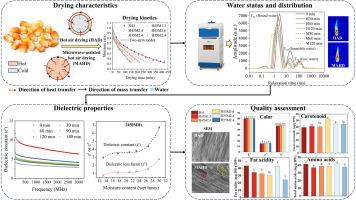Resonancia magnética nuclear de bajo campo (RMN-LF) La tecnología es una herramienta poderosa que se ha utilizado cada vez más en el estudio de la migración de humedad durante el proceso de secado de materiales alimentarios.. Esta técnica analítica y no invasiva proporciona información sobre la dinámica del agua dentro de las sustancias alimentarias., Lo cual es crucial para optimizar las condiciones de secado y garantizar la calidad de los alimentos..

En el contexto del secado de alimentos., LF-NMR es particularmente valioso para examinar el comportamiento del agua libre y unida.. agua gratis, que no está fuertemente asociado con las moléculas de los alimentos, se puede quitar fácilmente durante el secado. A diferencia de, El agua unida se retiene más firmemente y requiere más energía para eliminarla.. La capacidad de LF-NMR para distinguir entre estos dos estados del agua permite una mejor comprensión del proceso de secado y el impacto en la textura de los alimentos., propiedades de rehidratación, y calidad general.
La aplicación de LF-NMR en la investigación del secado de alimentos se ha destacado en varios estudios.. Por ejemplo, un estudio utilizó relaxometría LF-NMR T2 para investigar los mecanismos de transporte de agua libre y unida durante el secado, revelando que las membranas celulares se rompen en diferentes etapas del secado, dependiendo de la tasa de penetración de la energía térmica y del gradiente de presión entre los ambientes intracelular e intercelular . Esta información es vital para desarrollar métodos de secado más eficientes que puedan preservar las cualidades nutricionales y sensoriales de los alimentos..

Además, LF-NMR se puede utilizar para monitorear la distribución de humedad dentro de los materiales alimentarios en tiempo real, Proporcionar un medio para evaluar la uniformidad del proceso de secado.. Esta capacidad es particularmente útil para industrias que dependen de un control preciso del contenido de humedad para la calidad del producto y su vida útil., como en la producción de frutos secos, verduras, y granos.
Además de su papel en la investigación, LF-NMR tiene aplicaciones potenciales en el control de calidad de alimentos secos. Estableciendo una línea de base para la migración de la humedad y el estado del agua., LF-NMR puede ayudar a garantizar que los productos alimenticios cumplan con los estándares de seguridad y calidad.

En conclusión, LF-NMR es una tecnología versátil que ofrece importantes beneficios para el estudio y optimización de la migración de humedad durante el secado de alimentos.. Su capacidad para proporcionar información detallada sobre el estado del agua dentro de los materiales alimentarios lo convierte en una herramienta invaluable tanto para investigadores como para profesionales de la industria.. A medida que la tecnología continúa avanzando, Se espera que sus aplicaciones en el campo de la ciencia de los alimentos se expandan., Contribuir a mejoras en el procesamiento de alimentos y el aseguramiento de la calidad..
 mohoso
mohoso